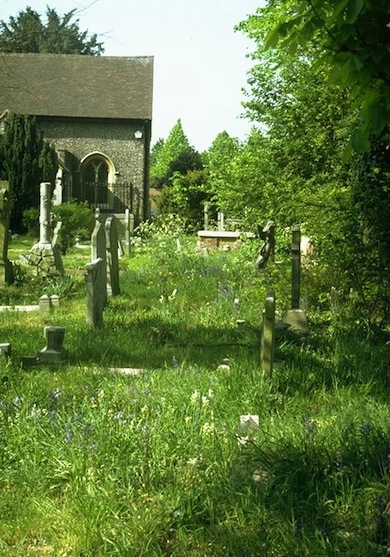Unlike the old churches at St Mary’s Wimbledon and St Lawrence’s Morden, St Mary’s Merton does not occupy a prominent position. Gilbert the Norman established the church in 1115 in what were then the fields of Merton. The site is in two sections, both owned by the church. To the east is the old churchyard, and to the west are the three glebe fields. Admiral Lord Nelson was once a regular worshipper here. The Merton Park housing developments of John Innes, whose monument is in the churchyard, slowly took up the open land to the north during the second half of the 19th century. The pastoral outlook remained to the south, and it was not until the arrival of the Northern line to Morden in 1926 that the fields of Morden Hall Farm were developed for housing. The glebe fields, however, being in the use of the church, remained an undeveloped oasis and are still there today.
Local Wildlife Site
Accessible Sites of Importance for Nature Conservation
St Mary's Churchyard and Glebe Fields, Merton Park
Borough: Merton
Grade: Local
Access: Free public access (all/most of site)
Area: 1.64 ha
Description
Wildlife
The churchyard is rectangular in shape, extending south from the church. Graves occupy much of the ground surface, with rarely mown grassland between. The grassland is much the same as in the glebe fields but is more sheltered and shaded with a variety of specimen trees, including one large copper beech and a row of limes and horse-chestnuts on the border with Church Lane to the east. In the shade beneath the trees alongside Church Lane, bluebells and cow parsley are attractive in spring and hedgerow crane's-bill later in the year.There are two glebe fields beside the western edge of the churchyard, but the hedge between these fields is now marked only by traces of a bank-and-ditch and a row of old horse-chestnuts. On the western side of the north field is an area of elm suckers and elder bushes, separating it from the third field. A path extends from the northwest corner of this field to the churchyard via the other two fields. The grassy fields retain their ancient, small and enclosed nature with common wildflowers, and are surrounded by tall lime trees and a variety of other native and exotic trees. An impressive list of birds has been seen on the site.The flora and fauna of Glebe Fields consist of species that are common in the pastoral countryside and what makes the area so special is that these plants and animals, along with their habitats, survive in the middle of suburban London.Facilities
Historic features; sculptures/ monuments
St Mary’s Churchyard, Merton Park © Ian Yarham
Feedback
Have a question or a comment for this site, or notice anything missing or out of date? Please contact us.
